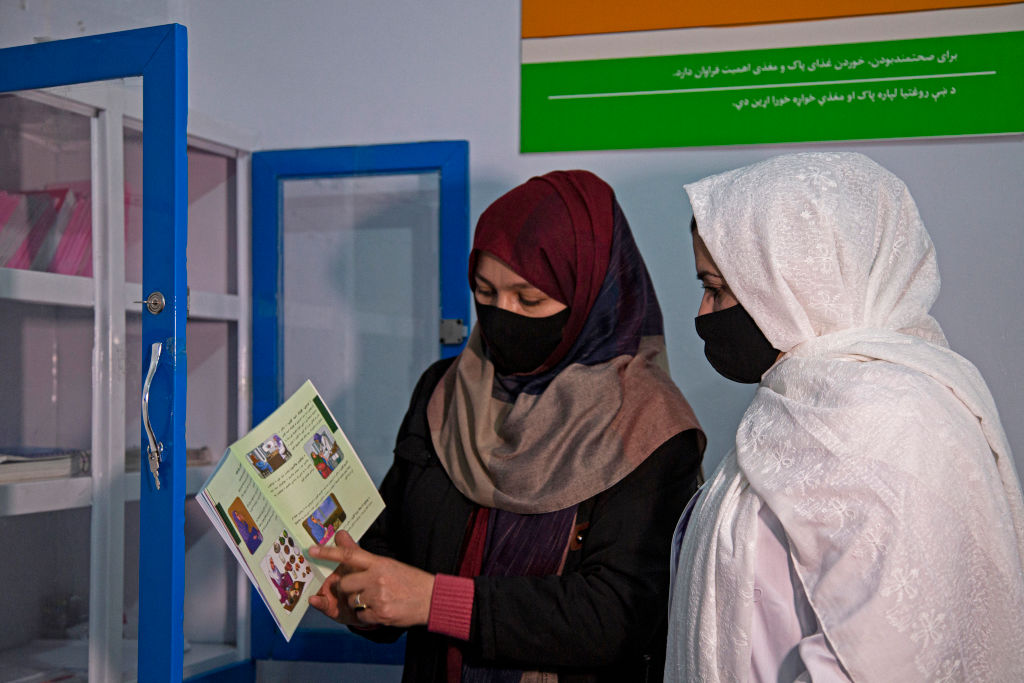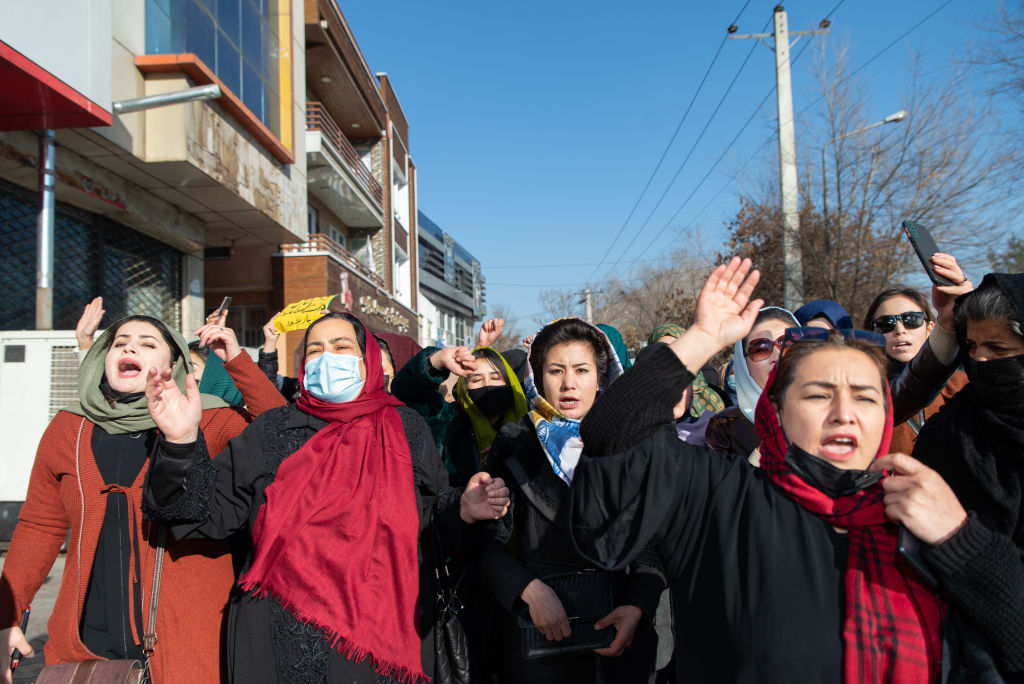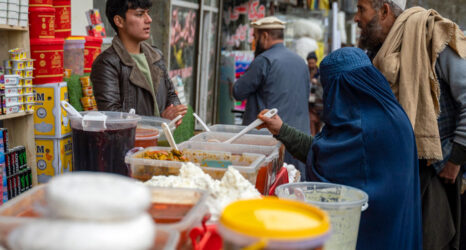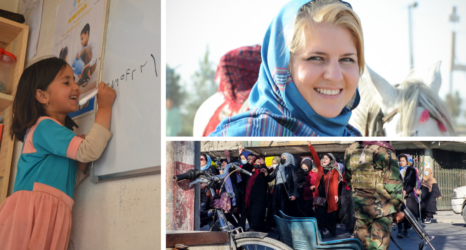It’s not just a shortage of hospital beds or incubators wrecking the well-being of women, according to experts—but also a wide range of economic, social and political factors.

This article was originally published by PassBlue, a women-led nonprofit newsroom that covers the U.N. and global women’s rights.
In the Taliban’s Afghanistan, it’s not uncommon for three women to share a hospital bed. Nor is it rare for premature babies to share incubators. This occurs in the most developed city, the capital of Kabul, and all over the country.
Families often cannot afford a trip to the doctor to get help for women or children, and more women are dying on their way to the hospital from pregnancy complications because they need to travel hours or even days to get care.
“Some women come in a very bad state,” said Dr. Hajira Zia, the head of gynecology and obstetrics at Faizabad Provincial Hospital in the remote Badakhshan Province. In November, she said four women died because they arrived too late. Some of these deaths often go unrecorded.
Even before the Taliban’s takeover in the summer of 2021, action that unleashed a new wave of economic and social calamities, Afghanistan had one of the highest maternal death rates in the world. Over two decades, the education of thousands of women medical workers and millions of dollars in foreign aid lowered the rate of deaths for every 100,000 live births to 620 in 2020 from 1,346 in 2000. By comparison, in Australia, one of the richest countries in the world, the number was 5.8 per 100,000 births.
With 24 women in Afghanistan dying every day in 2020 from pregnancy or birth-related causes, the country’s maternal death rate was still almost as high as all other South Asian countries combined.
“What’s tragic is that now you could look back to the situation in April of 2021 and feel like it’s some kind of halcyon vision of the past, when, in fact, it was very, very grim,” said Heather Barr, the interim co-director of the Women’s Rights Division at Human Rights Watch. “It’s just that we didn’t realize then how much worse things could get.”
It’s not just a shortage of hospital beds or incubators wrecking the well-being of women, according to experts who spoke with PassBlue from inside the country and outside, but also a wide range of economic, social and political factors.
“Women are affected from every side, but their health should not be affected. Their health should not be politicized,” said Dr. Najmussama Shefajo, head of the Afghan Society of Obstetricians and Gynecologists and a gynecologist at her own private clinic in Kabul. “Unfortunately, the health system is very politicized here in Afghanistan.”
After the Taliban took over the country, it lost billions in foreign aid as international organizations and other countries withdrew their support; the healthcare sector was heavily dependent on the funding.
“Unfortunately, in the past 20 years people responsible for the health system were not able to find a way to make it stand on its own feet without any support from the donors,” Dr. Nasrin Oryakhil, a former director of the Malalai Maternity Hospital in Kabul, said. “It always depended on the donor support.”
Dr. Oryakhil fled the country in 2021, but she remains an Afghan women’s rights activist and consults remotely as a doctor.
It’s a perfect storm: less access to healthcare, less access to reproductive choice, and a declining number of healthcare professionals.
Heather Barr, Human Rights Watch
A month after the Taliban took power in August 2021, most medical clinics and hospitals reported a scarcity of supplies and shortages in staff — challenges that worsened after doctors started to flee the country, straining those who stayed.
The United Nations and the International Committee of the Red Cross (ICRC) paid the salaries of thousands of Afghan medical workers who were affected by the loss of foreign aid and frozen overseas assets. The Red Cross terminated its funding of 25 Afghan hospitals in August 2023, saying it was intended as a temporary measure when the Taliban took power. The support covered everything from the salaries of more than 10,000 health workers to medicines and ambulance and generator fuel. (The UN is still paying salaries.)
Under the Taliban, the country has descended into “gender apartheid,” as Richard Bennett, the UN special rapporteur on human rights in Afghanistan, wrote in his recent report.
Less healthcare, younger pregnancies, higher risks
Despite the Taliban’s promises to take a moderate approach toward women and minority rights, in 2022 females were barred from going to school above the sixth grade. The ban was later expanded to higher education. (A few private schools, financed by overseas foundations, have stayed open.) The Taliban then blocked women from working for domestic and foreign nongovernmental organizations last spring, forbade them from attending gyms and public parks and prohibited them from traveling without a male chaperone.
They closed down women-run beauty salons, which played a crucial role as places where women could socialize and learn about family planning options. Domestic abuse shelters vanished, and the selling of contraceptives was outlawed.
“It’s a perfect storm: less access to healthcare, less access to reproductive choice, and a declining number of healthcare professionals,” Barr of Human Rights Watch said.
Asila Wardak, a prominent Afghan women’s activist and a former diplomat, now based in the US, recalled a story of a woman she knew in Afghanistan who died in childbirth. Without access to contraceptives and healthcare, the woman already had nine children. Without taking time to recover from those births, she became malnourished and anemic.
“Her stomach ruptured,” Wardak said. “She lost the baby and then she lost her life also.”
While the Taliban keep few statistics, experts working in maternal healthcare in the country and abroad believe that pregnancies have increased since their takeover. Doctors in Afghanistan as well as activists and former officials advocating for women’s health overseas said that poverty and a lack of opportunity for women in the country drive some families to marry off daughters sooner than in the past.
These observers said that there seemed to be more teenage pregnancies, which put young women at a higher risk for maternal morbidity and death.
Dr. Shefajo, who operates an ob-gyn clinic in Kabul, said that she noticed that the number of 14- and 15-year-old girls who come to her wanting to get pregnant or are pregnant has doubled in the last two years.
“I had a patient of about 15 years of age who couldn’t conceive because she was a child,” Dr. Shefajo said. “She was brought by her mother-in-law to [to help her] conceive. I was telling [the mother-in-law] that she was just a kid, but they pushed this child to conceive.”
“We have such cases every day,” she added.
Women often face pressure to get pregnant from their husbands and in-laws.
“Most of them are anemic and they do not have their own bodies fully developed yet,” Dr. Shefajo said in a Zoom interview in early December. “They are still kids in their height and their weight. Their bodies are not as mature as they can be to become a mother.”
Dr. Shefajo’s experiences align with the findings of a report by the Baltimore-based Johns Hopkins Center for Humanitarian Health, which said that one-third of healthcare workers and nongovernmental organizations surveyed in Afghanistan between February and April 2022 believed that maternal deaths have increased since August 2021. More than one-third (36.6 percent) believed that infant mortality has increased as well.
“[The] number of pregnancies, number of deliveries are also increasing day by day,” Dr. Shefajo said. “And mothers are dying because of the pregnancy and delivery and post-delivery complications.”
Dying en route to the hospital
To reach Faizabad Provincial Hospital in Badakhshan Province, located on the border with Tajikistan and Pakistan, some people have to travel for three days on dangerous roads. It’s the only hospital in the province, taking cases that other clinics can’t handle.
It’s where the desperate end up and doctors often see patients in a critical state.
For the last two decades, the hospital has been at the forefront in the fight against high maternal mortality rates plaguing the area. In 2002, the UN estimated that 64 percent of women of child-bearing age died in Badakhshan Province in pregnancy or childbirth, the highest rate in the world.
Dr. Hajira Zia, the head of gynecology and obstetrics at the Faizabad hospital, pushed to expand the gynecology wing from four beds in 2002 to the 90 they have now, saving many lives along the way.
But now the Taliban are cutting 60 beds from the wing and laying off 70 members of the medical staff. The World Health Organization once provided support for the hospital, but that is no longer the case, leaving Unicef, with the World Bank, alone to help.
“Maybe we would put patients on the floor. Maybe we would put five patients in one bed,” Dr. Zia said. “People are very poor. They can’t afford to go to another hospital.”
Faizabad hospital is often overcrowded and the staff stressed out.
“On a daily basis, due to the shortages of resources, we must refer some patients to Kunduz regional hospital, and many die on the way there,” hospital staff wrote in a letter to government officials.
Those 60 beds being cut had been “a beacon of hope,” the letter said. Keeping them available to the already vulnerable population of the province will “prevent a recurrence of the distressing health problems similar to rates documented in the 2002 statistical report.”
Dr. Zia, her staff and members of the Afghan Society of Obstetricians and Gynecologists advocated on behalf of the hospital, but their pleas were ignored.
“Nobody listens,” Dr. Shefajo of Kabul said. Her women’s clinic there serves many low-income patients, some of them traveling long distances to get there because many government hospitals are overcrowded.
Indeed, many women at the clinic can’t afford the medical procedures or medication they need, but with the help of a charity or with Dr. Shefajo’s sponsorship, the center helps a few women a day at no cost.
Education ban = fewer healthcare workers
The Taliban requirement that women must travel with a mahram, or male chaperone, not only restricts their movements but also their privacy.
“These rules about having to have a mahram to go see a healthcare provider are not just a barrier to accessing care but also a massive violation of women’s confidentiality, their medical privacy,” Barr said.
The ban on higher education for women is blocking the training of new women doctors, who are particularly important for maternal healthcare in a conservative country like Afghanistan, where many families prefer not to let female relatives be treated by male doctors.
While nursing and midwifery training are still available for women, they don’t fully substitute for doctors in many cases, especially emergencies. But the education ban means fewer women are entering these fields.

“With time, fewer and fewer women will be able to apply for posts as doctors, nurses and midwives,” said Anna Cilliers, the medical coordinator in Afghanistan for Doctors Without Borders.
The country faces a shortage of all types of doctors. According to the World Bank, even before a large number of doctors fled the country in 2021, Afghanistan had the lowest number of doctors per 1,000 people in Asia — 0.3 in 2016.
The question of how the rest of the world should engage with the Taliban, who remain unrecognized formally on the international stage, is an ongoing debate. The US, the European Union and the UN have pressed the Taliban to establish an inclusive government and implement laws safeguarding human rights, particularly those of women.
“The basic rights of women and girls, including the right to education and to work, and representation in public and political life, are not only fundamental obligations of a state but also critical to building state capacity for long-term development and economic growth and peace and security,” said an independent assessment on how to best deal with the Taliban, submitted to the UN Security Council in November.
The report, written by a Turkish diplomat, Feridun Sinirlioglu, outlined a strategy for political and economic involvement with the goal of reintegrating Afghanistan into the rest of the world. One key lever is the Taliban’s desire for official recognition to take the country’s seat at the UN.
“Afghan women are feeling completely forgotten by the world,” Barr said. “Foreign diplomats seem to either not realize or not care about the implications the crisis in Afghanistan has for women’s rights globally.”
Read more:





